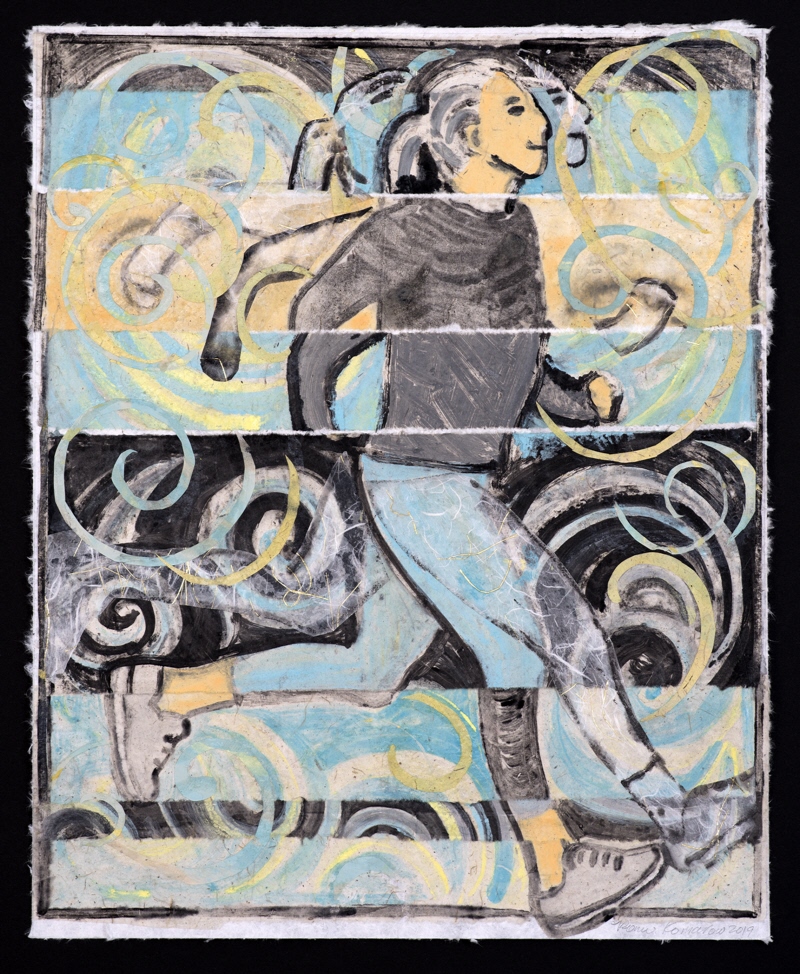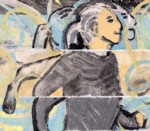 Ronni Komarow
Ronni Komarow
I run, I become 1
Monotype w/ collage
…..
Gail Monaghan
Physiology of Running
Spaulding Hospital
My field of study is the analysis of human motion. I am a physical therapist and I treat many runners. I have also studied human locomotion in a research laboratory. I am a teacher of motion not only in the clinic but also in schools of physical therapy.
My immediate associations with this runner are her running mechanics. I am looking at the length of the runner’s stride and which part of her foot contacts the ground. I am wondering why the chin of the runner is pointed up and that it could be potentially injurious to her neck. Mostly I am thinking of the cyclic nature of running and how the stride depicted repeats itself constrained within the laws of the mechanics, but for every individual the movement pattern is unique. The curled shaped strokes of paint throughout the picture evoke the spring-like motion of running, reminding me that the mechanics of running can be modeled by a spring.
Being first and foremost a clinician, the world I live in is both creative and scientific. After many years it is the integration of the artistic and the scientific that makes the job new every day. When envisioning a treatment plan for a patient I am analyzing the mechanics of their movement but also absorbing their aspirations, how that movement pattern or lack there of will impact the quality of their life. Treating patients is very much like the artistic process, there are many iterations of attempts at improving function.
When working as a scientist in research, the process is more constrained, we are interested in the relationship of just a few variables. The constraints are set as limits in the subjects included, the environment they are tested in and, if applicable, the treatment intervention. The scientific process is like the artistic process in creating the constraints and choosing the design of the study, this occurs at the beginning of the study and then in planning next steps after the results have been analyzed and discussed.

Mon domaine d’étude est l’analyse du mouvement humain. Je suis thérapeute physique et je traite beaucoup de coureurs. J’ai également étudié la locomotion humaine dans un laboratoire de recherche. Je suis un enseignant de mouvement non seulement à la clinique mais aussi dans les écoles de kinésithérapie.
Mes associations immédiates avec cette coureuse sont de sa mécanique de course à pied. Je regarde la longueur de la foulée de la coureuse et quelle partie de son pied touche le sol. Je me demande pourquoi le menton de la coureuse est relevé et que cela pourrait être potentiellement dangereux pour son cou. Je pense surtout à la nature cyclique de la course et à la façon dont la foulée représentée se répète, contrainte par les lois de la mécanique; mais pour chaque individu, le modèle de mouvement est unique.
Les coups de peinture courbés tout au long de l’image évoquent le mouvement de ressort de la course à pied, me rappelant que la mécanique de la course à pied peut être modelée par un ressort.
Etant d’abord et avant tout un clinicien, le monde dans lequel je vis est à la fois créatif et scientifique. Après de nombreuses années, c’est l’integration de l’artistique et du scientifique qui fait le travail nouveau chaque jour. Lorsque je conçois un plan de traitement pour un patient, j’analyse la mécanique de son mouvement, mais j’absorbe également ses aspirations et comment ce modèle de mouvement ou son absence aura un impact sur la qualité de leur vie. Traiter les patients est très semblable au processus artistique; il y a beaucoup d’itérations de tentatives d’amélioration de la fonction.
Quand on travaille comme scientifique en recherche, le processus est plus contraint; nous nous sommes intéressés par la relation de seulement quelques variables. Les contraintes sont définies en tant que limites dans les sujets inclus, l’environnement dans lequel elles sont testées et, le cas échéant, l’intervention du traitement. Le processus scientifique est comme le processus artistique en créant les contraintes et en choisissant la conception de l’étude; cela se produit au début de l’étude, puis dans la planification des prochaines étapes suite à l’analyse et à la discussion des résultats.